
Smashing satellites as part of the Delta 180 Strategic Defense Initiative missionby Dwayne A. Day
|
| Delta 180 was one of the most impressive examples of rapid spacecraft development of the Cold War. |
The mission was designated Delta 180, named after the vehicle number of the Delta rocket that launched it into space. Although it was an incredible rapid engineering accomplishment—going from program start to successful space intercept in less than 18 months—it was also a project with substantial domestic and international political impact. Delta 180 was intended to silence critics of the Star Wars program in the United States, but also to provide negotiating ammunition before the Reykjavik Summit in October, where President Ronald Reagan and Soviet Premier Mikhail Gorbachev met to discuss nuclear disarmament. The Reykjavik Summit ran into a significant stumbling block when Reagan refused Gorbachev’s demand to abandon SDI, raising the provocative question of whether Delta 180 had bolstered Reagan’s resolve, and maybe prevented him from achieving greater success at the summit.
The United States started work on developing anti-ballistic missiles in the 1950s and planned to field a very limited system by the early 1970s. By 1972 the United States and Soviet Union signed the SALT I Treaty, also known as the Anti-Ballistic Missile (ABM) Treaty. The treaty limited the testing and deployment of ABM weapons, and research on them dwindled in the United States during the 1970s. The United States completed a single ABM system in Grand Forks, North Dakota, and immediately shut it down. The Soviets had a limited system surrounding Moscow.
By the late 1970s there was discussion within American space and technology communities about placing an anti-ballistic missile system in space. Early concepts focused on space-based interceptors, but by the early 1980s there was discussion of space-based directed energy weapons such as lasers and particle beams. The concept appealed to President Ronald Reagan, who envisioned the possibility of making nuclear weapons ineffective and obsolete. Reagan announced the Strategic Defense Initiative in a nationally televised address in March 1983. Critics quickly labeled it “Star Wars,” but soon the Department of Defense began mobilizing to conduct research to develop a space-based anti-missile “shield.” This included creating the Strategic Defense Initiative Office (SDIO) to manage the technology development.[1]
The Johns Hopkins University’s Applied Physics Laboratory, located in Maryland outside of Baltimore, had been involved in space and missile programs for decades when, after Reagan’s speech, they were approached about participating in the Strategic Defense Initiative, offering some “low level technical support in areas such as guidance, control, structures, thermodynamics, and electronics.” APL managed to turn this “low level technical support” into a substantial space program involving multiple launches of satellites of increasing sophistication.
By 1984, APL was tasked with investigating a possible near-term space intercept. They were told that any test had to be compliant with the 1972 Anti-Ballistic Missile Treaty. The test had to be “look down, shoot down” and had to be accomplished within two years. They were warned that if the test expanded to 30 months, it would probably not be approved.[2]
APL assembled a team that was given an even greater challenge by SDIO leadership: “What can you do in a year?” That tight constraint “turned our thinking around completely,” according to two of the team leaders, John Dassoulas and Michael Griffin. It immediately ruled out several launch options. The Space Shuttle was out as a launch platform because payload integration and safety requirements would add too much time to the project. They could also only use existing technology. Finally, to save time, they could only produce minimal documentation of their work. Dassoulas and Griffin developed a schedule and prepared to tell SDIO that they could conduct a test in a year.
The APL team considered several guidance systems but conservatively chose radar guidance over other options such as laser radar (ladar), passive infrared, passive ultraviolet, and millimeter wave radar. They knew that radar had a poor track record at enabling a direct hit of a target, but it could get an interceptor close enough that a fragmentation warhead could destroy it.
| The program was executed in 14 months and cost $150 million, plus $42 million for the launch vehicle. Program managers estimated that a program of that complexity would normally take three to five years and cost $300–500 million. |
By January 1985, they developed a “kluged up” interceptor based on a tactical missile radar seeker with a warhead. The interceptor would be rocket powered and, because it was in space, could not use aerodynamic control surfaces or guidance systems. They considered several possible missiles, including the ship-launched Standard Missile, the Phoenix long-range air-to-air missile, and even the Advanced Medium Range Air-to-Air Missile (AMRAAM), then in development.
A key issue remained: how to launch their interceptor. Having ruled out the shuttle, that left America’s rather dwindling fleet of expendable launch vehicles. The Scout was too small, and Titan and Atlas rockets were unavailable. But program managers discovered that two or three Delta rockets were available because NASA had moved their payloads onto the shuttle.[3]
The project was informed that their proposal would be reviewed along with others on February 20, and were provided a briefing by members of the political and legal staffs from the Department of Defense and State Department about compliance with the Anti-Ballistic Missile Treaty. Up until that time, the team had assumed that they would intercept a target such as a ballistic missile. But the ABM Treaty did not allow the use of a space-based system to intercept a ballistic missile. To remain compliant with the treaty, they would have to intercept a non-ballistic target.
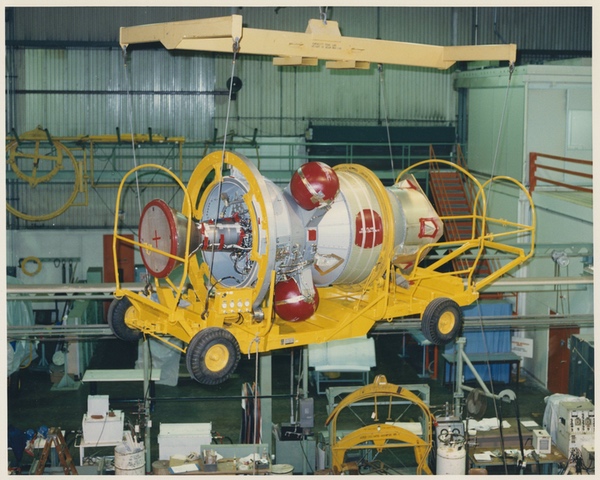 The Delta upper stage during assembly. The upper stage had restart capability, which made it useful as a target for the interceptor. It was also equipped with instruments to image the interceptor. Because both the interceptor and upper stage had the same rocket engines, the interceptor could not chase the target, requiring that the interception be head-on. (credit: SDIO) |
Mike Griffin realized that the Delta second stage was restartable. If they used that stage as their target, they could comply with the ABM Treaty. They came up with a plan to place the interceptor in orbit, then re-start the second stage along a non-ICBM trajectory to remain treaty-compliant and intercept it with their spacecraft.[4]
In the course of getting the mission approved, the APL team was asked to provide “some cooperation” by the target “to help ensure success of both the approval process and the intercept.” The team added a corner reflector to the Delta second stage that enhanced its radar signature. The purpose of the test was to demonstrate that guidance and control could work for an intercept, not to demonstrate detection technologies. They were not going to use this radar again, and the test was not focused on the best techniques for detection. That would come later.
The SDIO overview took place as planned on February 20, 1985. According to Dassoulas and Griffin, most of the other proposals that were reviewed were not compliant with the ABM Treaty. Griffin and Dassoulas also stated that the other proposals were expensive and would take too long. The APL team received a go-ahead, and after high-level meetings between SDIO and NASA officials, they received permission to use a Delta rocket.
The APL team still had to select a seeker and propulsion system for the interceptor. They initially sought any leftover hardware from the Homing Overlay Experiment (HOE), the first hit-to-kill system tested by the US Army. It was also the first successful hit-to-kill intercept of a mock ballistic missile warhead outside the Earth’s atmosphere. Four tests were conducted in 1983 and 1984, but only the fourth was successful. But the APL team was informed that there was no HOE hardware available for use.[5]
Dassoulas then approached McDonnell Douglas about any spare Delta second-stage engines. Not only did McDonnell Douglas have the hardware, but a rapid assessment confirmed that it would be appropriate for their needs. McDonnell Douglas then became a systems contractor in addition to providing the launch vehicle.[6]
The team soon decided that the air-to-air Phoenix missile was the best choice for their seeker. The Phoenix was carried by the legendary F-14 Tomcat and was a long-range missile designed to destroy bombers before they could fire their cruise missiles to attack an aircraft carrier. The Phoenix had an active radar seeker that emitted and detected the radar return from the target. In March the team visited Hughes Aircraft Co. to learn more about the seeker system and soon selected it for their spacecraft.
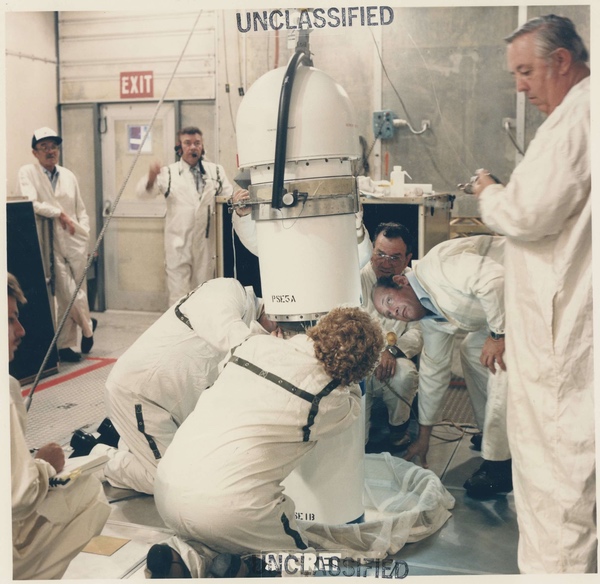 Technicians attaching the radar seeker to the interceptor (euphemistically referred to as the “Science Payload”). The radar was taken from an AIM-54 Phoenix missile used by the F-14 Tomcat. (credit: SDIO) |
The team quickly began conducting guidance and control simulations. Because both the Delta upper stage and the interceptor used the same rocket engines, they had similar characteristics. Generally, an interceptor needed to have at least a three-to-one lateral acceleration advantage over the target. The similarities in propulsion systems meant that the interceptor could not chase the target and therefore required that the intercept had to be head-on.[7]
The program kick-off came on May 15–16, and the project rapidly expanded. The Preliminary Design Review was held in June 1985.[8] One change made during development was that the project added infrared sensors to the spacecraft.[9] The program was named Vector Sum.
| The rocket number was unclassified and so the program was often referred to as Delta 180 by those who did not know the nature of the classified satellite. |
According to an overview of APL’s Strategic Defense Initiative work, “Major modifications to the AIM-54C Phoenix missile for spaceflight included a new radome, gyros, software, fuze, and warhead. The Phoenix was integrated with the new third stage to complete the interceptor.” The interceptor, with its sensors and guidance system, was referred to as the “Science Module.” The Delta stage contained the sensor module and it contained a modified AGM-45 Maverick infrared seeker as well as an ultraviolet/visible imager/spectrometer sensor, and an additional infrared telescope. They were intended both to image the interceptor in flight, as well as a rocket launched from the ground. APL designed and fabricated the sensor module, and it was integrated with the Delta stage. The Delta stage was also modified to enable four engine starts as well as the ability to respond to ground commands from the Delta Program Operational Control Center.[10]
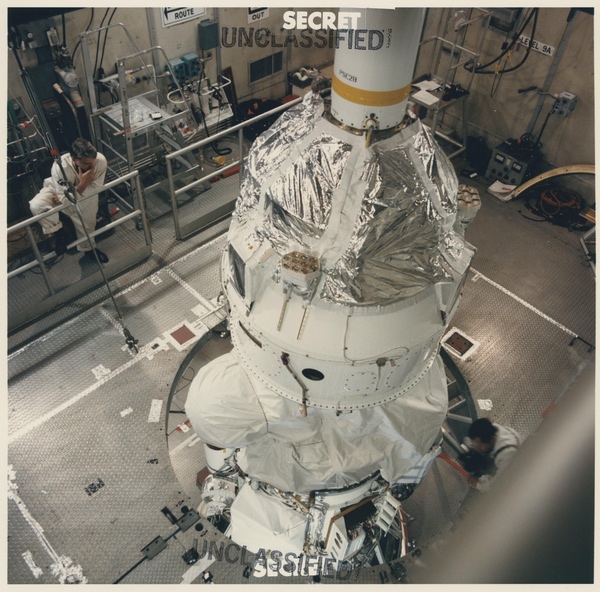 The interceptor atop the Delta upper stage that also served as the target. The spacecraft was built in record time and used a lot of pre-existing equipment. A major aspect of the mission was proving the navigation and control for an interception. Developing new sensors would occur later. This photo was taken at the launch site. (credit: SDIO) |
Construction of the spacecraft and instruments continued into 1986, and the program was executed in 14 months and cost $150 million, plus $42 million for the launch vehicle. Program managers estimated that a program of that complexity would normally take three to five years and cost $300–500 million.[11]
Development proceeded quickly. The spacecraft was shipped to Cape Canaveral in June 1986 and prepared for integration atop Delta rocket number 180. The rocket number was unclassified and so the program was often referred to as Delta 180 by those who did not know the nature of the classified satellite.
The payload and the mission were classified and very little information was publicly released. A June SDI report to Congress described the mission as “a single launch device that puts two vehicles in closely related orbits,” adding that “the vehicles will be maneuvered relative to each other to obtain sensor, guidance and navigation data. The experiment is a multifaceted exoatmospheric experiment involving research into the area of vehicle dynamics, guidance and sensor sciences.”[12] The report mentioned nothing about a physical interception.
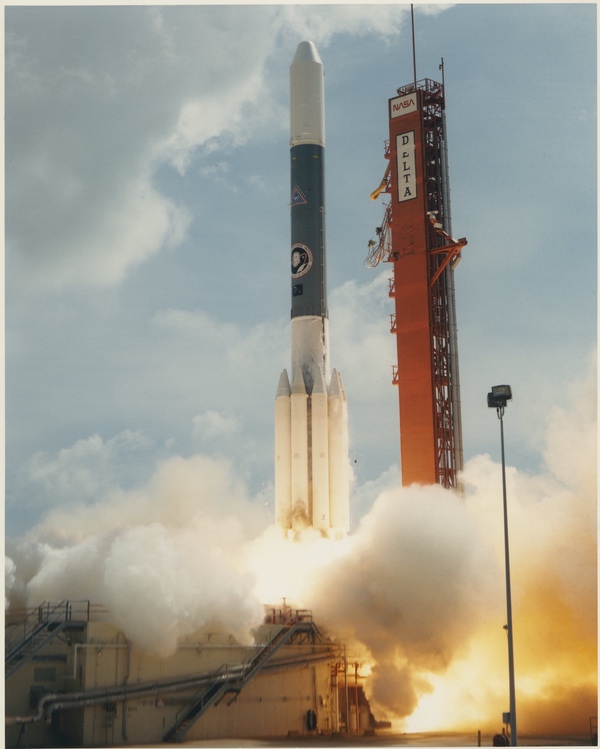 The Delta 180 mission was also known as the Vector Sum Experiment and was launched from Florida in September 1986. This was the first American launch success after a string of failures that began in August 1985 and included the January 1986 Challenger accident. Journalists were only informed of the impending launch the morning that it occurred. (credit: SDIO) |
The day and exact time of the launch had been kept secret for weeks. On Wednesday, September 3, 1986, reporters were given a heads-up to come to Kennedy Space Center on Friday morning. At 7 am on Friday, NASA officials called reporters and told them of the impending launch, which they said was embargoed information. Reporters were allowed to travel to the launching site under security.[13]
The Delta 180 was launched from Cape Canaveral on Friday, September 5, 1986, at 11:08 am amid unusual secrecy.[14] Less than three hours after launch, the two modules smashed into each other at a closing velocity of 2.9 kilometers per second.[15] In Washington, an SDI spokesman said that the Delta payload was a “Significant Technical Milestone Experiment,” but provided no details.[16]
| Lieutenant Colonel Michael Rendine, the program manager for the first large-scale experiment in the SDIO program, described the test as “a storybook mission” that showed “our job is going to be a lot easier than we ever imagined.” |
The United States had suffered a series of rocket launch failures during the previous year. In August 1985, a reconnaissance satellite launch from Vandenberg Air Force Base had failed. In January 1986, the shuttle Challenger had been destroyed. In May 1986, a GOES weather satellite had been destroyed during launch atop the same kind of Delta rocket scheduled to launch the SDI payload. And in April 1986, another reconnaissance satellite launching from Vandenberg blew up in a spectacular explosion above the launch pad. In addition to the orbital rocket launch failures, there had been other suborbital failures in 1986, including a Nike-Orion research rocket, an Aries rocket with an X-ray telescope, and a Minuteman III missile on a test flight.[17] The Delta 180 launch was the first success in a year and a half. “We’re back in the groove,” William A. Russell Jr., NASA’s Delta Project manager said at a news conference at Cape Canaveral Air Force Station after the launch.[18] Although NASA was not involved in the mission, it oversaw Delta launches for the US government.
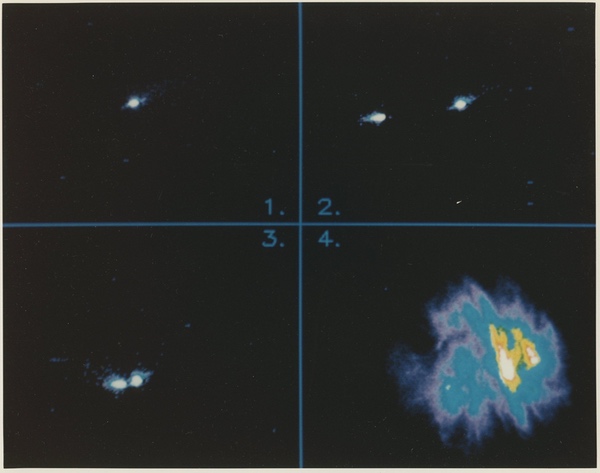 The two spacecraft smashing into each other over the Pacific Ocean. The United States observed the mission using multiple sensors, making it a highly complex operation. It also had to comply with the requirements of the 1972 ABM Treaty, meaning that the intercept could not involve a ballistic warhead or trajectory. (credit: SDIO) |
At 3:45 pm, the SDI office in Washington announced the “successful completion” of the experiment. “The primary objective was to obtain scientific data on rocket signatures during the close-in phase of a space intercept.” Again there was no statement about two spacecraft smashing into each other.[19]
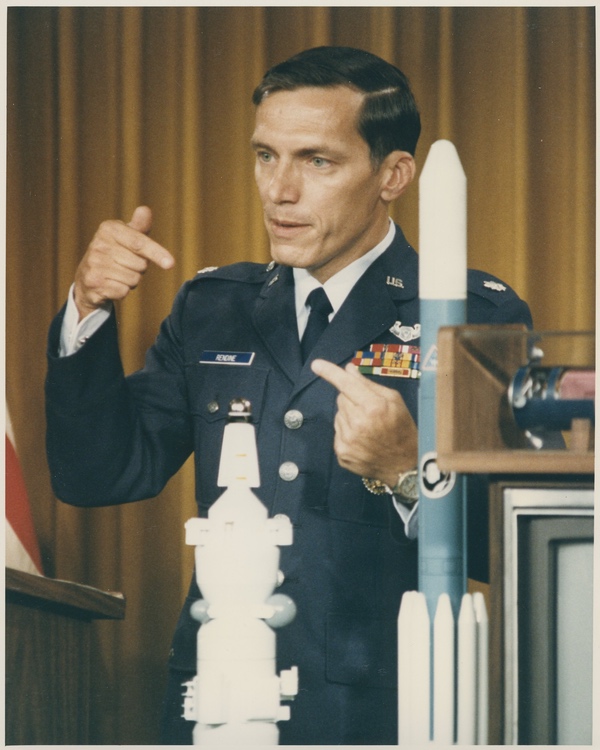 Lt. Col. Michael Rendine, the program manager, describing the intercept a week after it occurred. (credit: SDIO) |
The mission was the first major experiment to be conducted entirely in space in the SDIO program.[20] Before the launch, DoD kept the details classified and in particular avoided any mention of plans to conduct a kinetic intercept. But a week later, on September 12 they held a one-hour press conference with models, photographs, and video showing the collision in space. According to The New York Times, Lieutenant Colonel Michael Rendine, the program manager for the first large-scale experiment in the SDIO program, described the test as “a storybook mission” that showed “our job is going to be a lot easier than we ever imagined.”[21]
Lieutenant General James Abrahamson, director of SDIO, said that the test did not involve prototype weapons but was primarily intended to collect data and explore technologies that need further development. Abrahamson declined to say when the technologies would be ready for deployment, saying that was up to congressional willingness to pay for further experiments.[22]
According to the Times, “the main point of the experiment was to use several heat-sensing devices and cameras to examine details of rocket exhaust plumes in space, a complex phenomenon that has never been examined at close range.”[23] In a 2020 interview with historian Aaron Bateman, Mike Griffin stated emphatically that Delta 180 was a guidance and navigation test, not a sensor test. Advanced sensors for missile interception would come later. In 2005, Griffin would become NASA administrator.
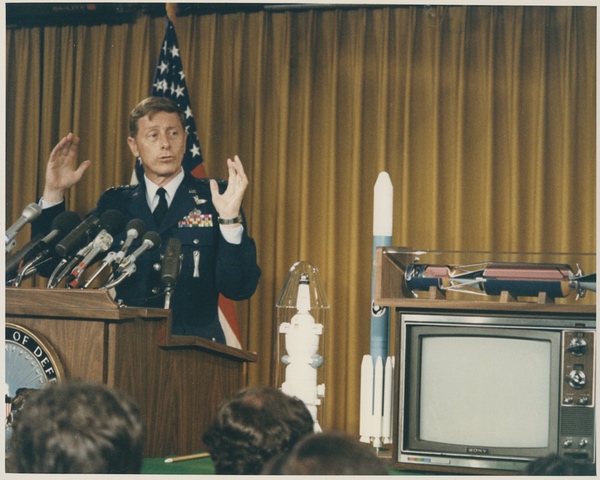 Lt. Gen. James Abrahamson ran the Strategic Defense Initiative Office and described the mission at a public press conference a week after it occurred. The amount of information presented at the press conference, including photos, video, and models, contrasted sharply with the secrecy only a week earlier. A major aspect of the SDI program was convincing skeptics—including not only the Soviet Union, but American politicians and the public—that space-based missile defense could work. (credit: SDIO) |
After the substantial pre-launch secrecy, SDIO was much more open about the results of the successful mission. Trade publication Aviation Week and Space Technology covered the mission after it happened.[24] Soon a photograph of the spacecraft being prepared for launch was on the cover of the magazine.[25]
Senior Pentagon officials claimed that the secrecy reflected genuine security concerns because some of the information collected was not encrypted and providing details about the test beforehand would have made it easier for the Soviet Union to send ships and planes to monitor the test.[26]
| Gorbachev wanted the United States to end the SDI program and Reagan refused, perhaps bolstered by the successful Delta 180 test. |
However, other, unnamed administration officials claimed that the Pentagon’s willingness to be so open about the successful test raised questions about whether the experiment needed to be so highly classified in the first place. “It suggests that the classification procedures are being somewhat abused,” The New York Times quoted an administration official who wished to remain anonymous.[27]
John Pike, associate director of the Federation of American Scientists and critic of the SDI program, claimed that the Pentagon initially withheld some information to influence news coverage. The Pentagon “was deliberately vague about the goals of the test before it was held so that if things went wrong it would not be perceived as a failure,” he said.[28]
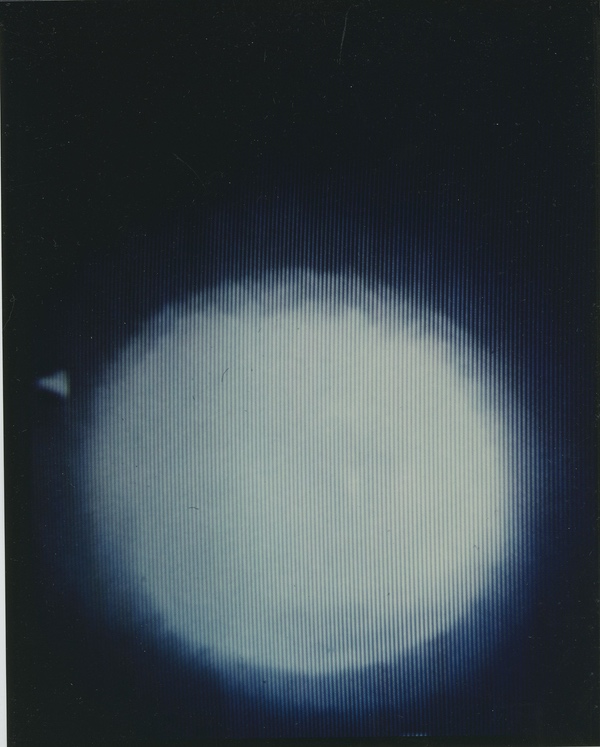 The kinetic impact was observed by many US sensors. The government claimed that the mission launch time and goals were kept secret in order to prevent the Soviet Union from moving intelligence collection assets into place to observe the test. (credit: SDIO) |
In October 1986, Ronald Reagan and Soviet Premier Mikhail Gorbachev traveled to Reykjavik, Iceland, for a summit to discuss strategic arms reductions. The talks between the two men were extraordinary in many ways, with them discussing topics that had never been broached before between the leaders of the two nations. But Gorbachev wanted the United States to end the SDI program and Reagan refused, perhaps bolstered by the successful Delta 180 test. The talks collapsed at the last minute. Despite the failure of the talks, the discussion eventually led to the 1987 Intermediate-Range Nuclear Forces Treaty.
From a technical and management standpoint, Delta 180 had been a tremendous success. According to the program summary produced by the program management: “A number of incidental accomplishments turned out to be of major proportions: creation of more than a million lines of new software to support guidance and control; orbital safety and real-time satellite operations by the worldwide network; and integration of 170 range assets, including ten test ranges, thirty-eight radars, thirty-one satellite links, and four aircraft into the largest network ever used in a space operation. These assets are preserved as the Space Test Range. Another first was the use of gimbal cameras in aircraft for metric measurements. These cameras were directed by Kwajalein Missile Range radars via satellite link and the aircraft inertial navigation system.” [29]
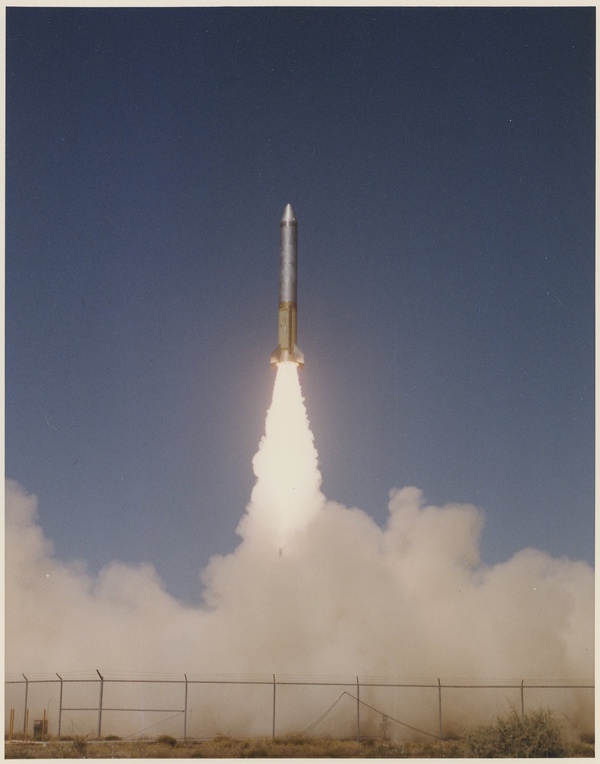 An Aries rocket launched during the Delta 180 mission. It was observed by sensors on the spacecraft. Detecting, tracking, and characterizing missiles and warheads in flight against the warm Earth background was a major aspect of the SDI program during the 1980s. (credit: SDIO) |
The program summary also discussed the accomplishments of the spacecraft. “With the exception of the actual intercept, all maneuvers and events were carried out open loop,”—meaning that the actions were not pre-programmed but the systems responded in real time during the test—“including the synchronized launch of an Aries rocket from White Sands Missile Range within one-tenth of a second of the desired time for imaging by the orbiting sensor module.” The ground-based aspects of the test had been substantial as well. “Significant upgrades to the National Test Ranges to conduct the real-time control from the Eastern Test Range included the capability to receive, record, and evaluate quick-look telemetry using eighty percent of the available bandwidth of the S-band downlink. Technical contributions to the aerospace community resulting from the Delta 180 success include the first thrusted intercept in space, the acquisition of revolutionary new data on rocket plumes in the space environment, the first flight of a laser radar in space, and significant improvements in hypervelocity debris models and orbital safety computer predictions. Ultraviolet sensing of rocket plumes, because of the success of the APL instrumentation and analysis on Delta 180, has now become an important tool in space booster and space object identification.”[30]
Despite this technical success, Delta 180 remains somewhat of an enigma. Because it used existing hardware and was conducted so quickly, it is unclear if it made any substantive technical contributions to later missile defense projects. Although it gathered sensor data about rocket plumes in space, it may have been primarily valuable for domestic and international messaging, as well as political value. Did it bolster Ronald Reagan to take a more aggressive stance during the Reykjavik summit and give him confidence in SDI that was not really warranted? What discussions about the test took place within the White House before and after the test, and how did they affect policy? Did White House officials discuss what to say publicly if the test failed? Those records are almost certainly still classified. Until they are released, we are unlikely to know if the White House thought that Delta 180 “proved” that SDI could work or viewed the test as primarily of political value.
| Despite this technical success, Delta 180 remains somewhat of an enigma. Because it used existing hardware and was conducted so quickly, it is unclear if it made any substantive technical contributions to later missile defense projects. |
In fact, much of SDI remains an enigma. The program launched approximately a dozen spacecraft, some of them carrying missile and warhead-detecting sensors far more sophisticated than those quickly adapted for Delta 180. But SDIO was never anywhere close to the goal of developing a deployable missile defense, an incredibly complex project requiring detecting and tracking thousands of warheads and controlling the response by thousands of interceptors. There were people within Reagan’s own administration who did not believe that SDI was technically feasible, and who were interested in seeing him trade it in return for something tangible during arms control talks. That did not happen before the collapse of the Soviet Union. The limitations of SDI became apparent to American political and military leadership, and by the early 1990s American missile defense projects were redirected towards the much easier, but still challenging, task of ground-based defense against tactical missiles.
Today we are left with many what-if questions about SDI, and it is still unclear if the technical achievements of Delta 180 and its successors made their way into other systems or were primarily technological dead ends. The history of the Strategic Defense Initiative and the role that its technical projects played in influencing the political landscape remain a target rich environment largely unexplored by historians.
Note: we are using a new commenting system, which may require you to create a new account.